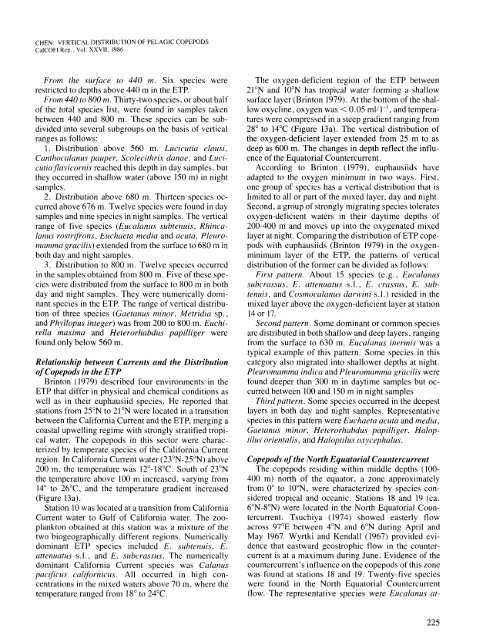CalCOFI Reports, Vol. 27, 1986 - California Cooperative Oceanic ...
CalCOFI Reports, Vol. 27, 1986 - California Cooperative Oceanic ...
CalCOFI Reports, Vol. 27, 1986 - California Cooperative Oceanic ...
- No tags were found...
You also want an ePaper? Increase the reach of your titles
YUMPU automatically turns print PDFs into web optimized ePapers that Google loves.
CHEN: VERTICAL DISTRIBUTION OF PELAGIC COPEPODSCalCOFl Rep.. <strong>Vol</strong>. XXVII. <strong>1986</strong>From the surface to 440 m. Six species wererestricted to depths above 440 m in the ETP.From 440 to 800 m. Thirty-two species, or about halfof the total species list, were found in samples takenbetween 440 and 800 m. These species can be subdividedinto several subgroups on the basis of verticalranges as follows:1. Distribution above 560 m. Lucicutiu clausi,Canthocalanus pauper, Scolecithrix dunae, and Lucicutiaflavicornisreached this depth in day samples, butthey occurred in shallow water (above 150 m) in nightsamples.2. Distribution above 680 m. Thirteen species occurredabove 676 m. Twelve species were found in daysamples and nine species in night samples. The verticalrange of five species (Eucalanus subtenuis, Rhincalanusrostrifrons, Euchaeta media and acuta, Pleuromammagracilis) extended from the surface to 680 m inboth day and night samples.3. Distribution to 800 m. Twelve species occurredin the samples obtained from 800 m. Five of these specieswere distributed from the surface to 800 m in bothday and night samples. They were numerically dominantspecies in the ETP. The range of vertical distributionof three species (Gaeranus minor, Metridia sp.,and Phyllopus integer) was from 200 to 800 m. Euchirellamaxima and Heterorhabdus papilliger werefound only below 560 m.Relationship between Currents and the Distributionof Copepods in the ETPBrinton ( 1979) described four environments in theETP that differ in physical and chemical conditions aswell as in their euphausiid species. He reported thatstations from 25"N to 21"N were located in a transitionbetween the <strong>California</strong> Current and the ETP, merging acoastal upwelling regime with strongly stratified tropicalwater. The copepods in this sector were characterizedby temperate species of the <strong>California</strong> Currentregion. In <strong>California</strong> Current water (23"N-2S0N) above200 m, the temperature was 12"-18°C. South of 23"Nthe temperature above 100 m increased, varying from14" to 26"C, and the temperature gradient increased(Figure 13a).Station 10 was located at a transition from <strong>California</strong>Current water to Gulf of <strong>California</strong> water. The zooplanktonobtained at this station was a mixture of thetwo biogeographically different regions. Numericallydominant ETP species included E. subtenuis, E.artenuatus s.l., and E. subcrassus. The numericallydominant <strong>California</strong> Current species was Calunuspacificus cafifornicus. All occurred in high concentrationsin the mixed waters above 70 m, where thetemperature ranged from 18" to 24°C.The oxygen-deficient region of the ETP between21"N and 10"N has tropical water forming a shallowsurface layer (Brinton 1979). At the bottom of the shallowoxycline, oxygen was < 0.05 mill-', and temperatureswere compressed in a steep gradient ranging from28" to 14°C (Figure 13a). The vertical distribution ofthe oxygen-deficient layer extended from 25 m to asdeep as 600 m. The changes in depth reflect the influenceof the Equatorial Countercurrent.According to Brinton (1979), euphausiids haveadapted to the oxygen minimum in two ways. First,one group of species has a vertical distribution that islimited to all or part of the mixed layer, day and night.Second, a group of strongly migrating species toleratesoxygen-deficient waters in their daytime depths of200-400 m and moves up into the oxygenated mixedlayer at night. Comparing the distribution of ETP copepodswith euphausiids (Brinton 1979) in the oxygenminimumlayer of the ETP, the patterns of verticaldistribution of the former can be divided as follows:First pattern. About 15 species (e.g., Eucalanussubcrassus, E. attenuatus s.I., E. crassus, E. subtenuis,and Cosmocalanus darwini s.1.) resided in themixed layer above the oxygen-deficient layer at station140r 17.Second pattern. Some dominant or common speciesare distributed in both shallow and deep layers, rangingfrom the surface to 630 m. Eucalanus inermis was atypical example of this pattern. Some species in thiscategory also migrated into shallower depths at night.Pleuromamma indica and Pleuromamma gracilis werefound deeper than 300 m in daytime samples but occurredbetween 100 and 150 m in night samplesThird pattern. Some species occurred in the deepestlayers in both day and night samples. Representativespecies in this pattern were Euchaeta acuta and media,Gaetunus minor, Heterorhabdus papilliger, Haloptilusorientalis, and Haloptilus o,rycephalus.Copepods of the North Equatorial CountercurrentThe copepods residing within middle depths (100-400 m) north of the equator, a zone approximatelyfrom 0" to IO"N, were characterized by species consideredtropical and oceanic. Stations 18 and 19 (ca.6"N-S"N) were located in the North Equatorial Countercurrent.Tsuchiya (1974) showed easterly flowacross 97"E between 4"N and 6"N during April andMay 1967. Wyrtki and Kendall (1967) provided evidencethat eastward geostrophic flow in the countercurrentis at a maximum during June. Evidence of thecountercurrent's influence on the copepods of this zonewas found at stations 18 and 19. Twenty-five specieswere found in the North Equatorial Countercurrentflow. The representative species were Eucalanus at-225















